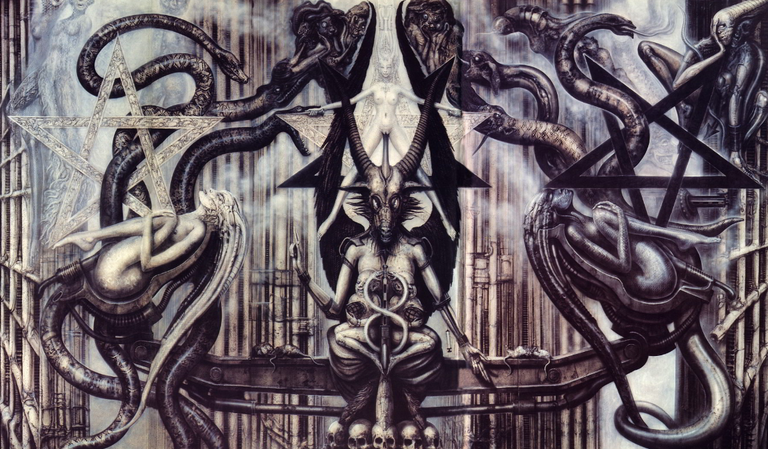
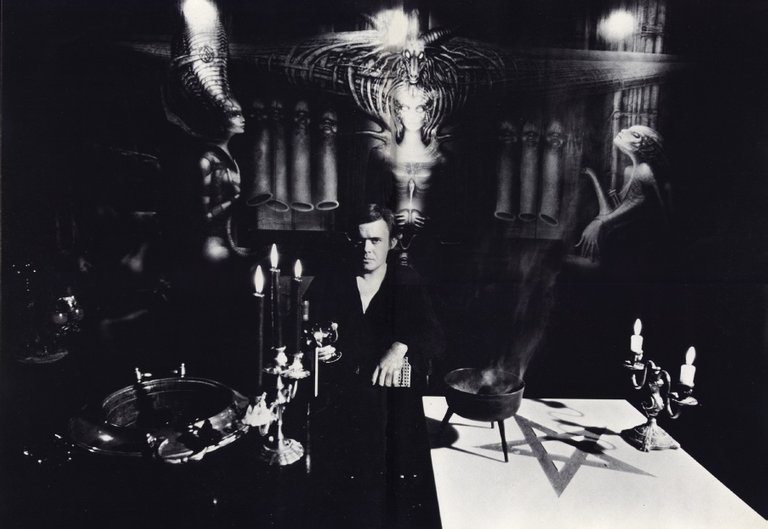
My previous post in this minor series on HR Giger and Pizzagate is available here, and is recommended reading before diving into the full significance of Giger's occult ties. This subject may prove too large to cover in one piece, in which case I will break it down into topic-specific parts.
Some readers may already be familiar with Giger's involvement in the creation of a set of Tarot cards titled The Baphomet Tarot, produced with the Swiss occultist, Akron. The title of the series comes as little surprise, given the centrality of Levi's Baphomet image in of Giger's occult works.
Below: Akron in 2017

In researching Giger's work with Akron, I stumbled upon a lengthy interview of Giger by the host of an occult-themed website, "GlennFWright." During the interview, Giger at first professes very little knowledge of Tarot. Whether that response was truthful is a matter for speculation. Giger also discusses his one-time fascination with the Baphomet image:
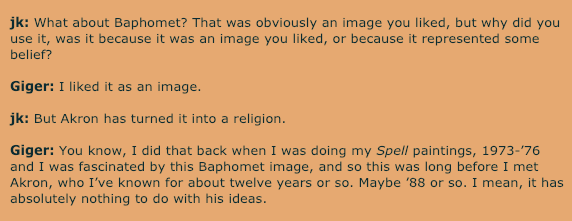
Giger repeatedly makes an effort to separate his work from "Akron's ideas." In accounting for his attraction to Baphomet, Giger also mentions having read Eliphas Levi's book Transcendental Magic. Levi, as discussed later in this article, drew the Baphomet figure on which Giger's images were based.
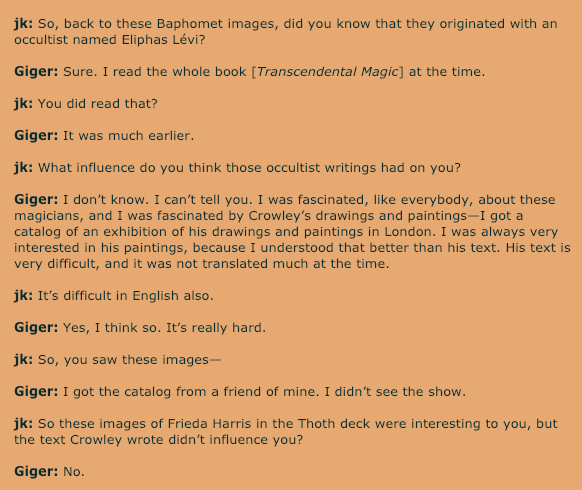
Above, Giger also describes his interest in Crowley, especially his painted works.
Later in the interview, Giger and his interviewer are discussing a specific series of works titled Pump Excursion, painted in the late 1980s.
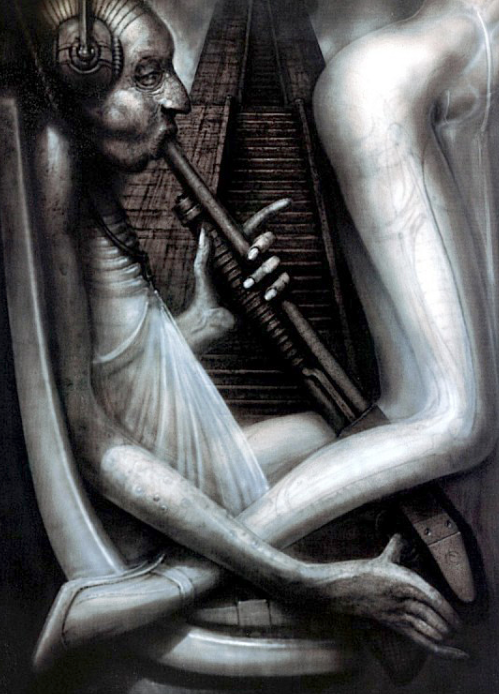
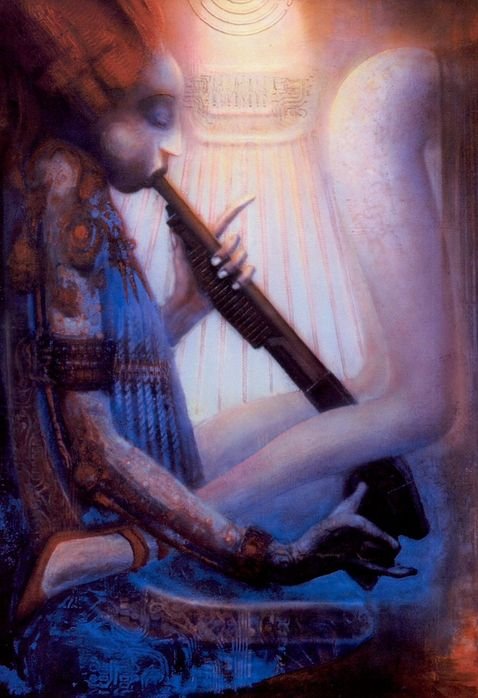
Fascinatingly, Giger confirms that the background in the series is intended to represent Mayan/Aztec pyramids. Going further, the interviewer directly references the ritual sacrifices which took place on such pyramids, including the removal of the heart.

As a reminder, here are depictions of the steps Giger included or referenced in "Pump Excursion," in their ritual/sacrificial use:
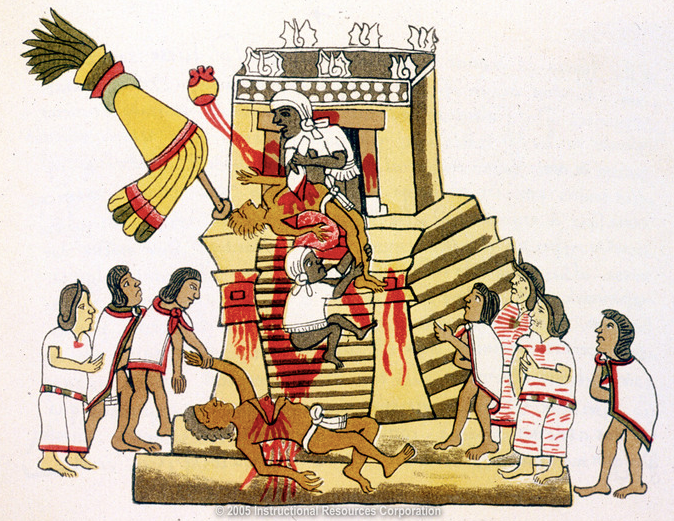
This writer previously discussed Mayan/Aztec cannibalism, in relation to Marina Abramovic's trip to Brazil. Since that time, a spiritual "practitioner" she met and worked with while there has been accused of sexual abuse among many patients, but that is a story for another time.
In this author's opinion, this Mayan/Aztec reference is far more indicative of experience or awareness of ritual abuse than the inclusion of Levi's Baphomet in Giger's works, or the depiction of Crowley in others.
Giger also created this image in 2009, titled "Caravan (with Martin Schwarz)."
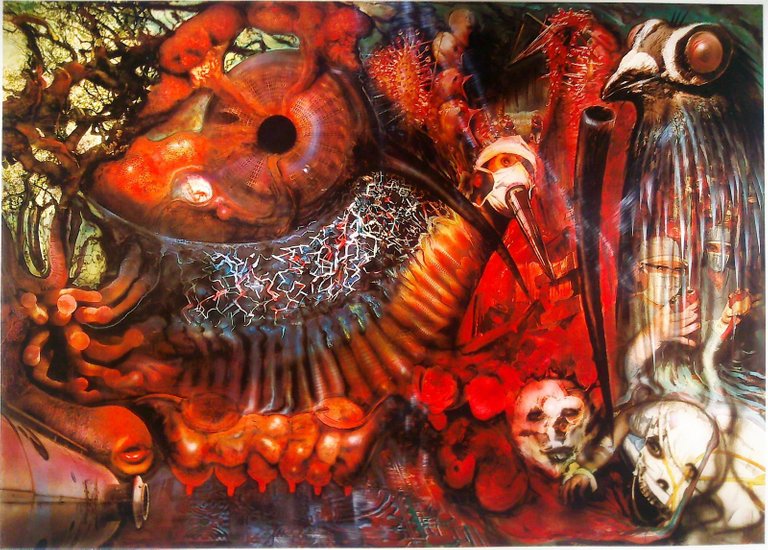
The image includes an eye, what looks like surgeons in surgical garb, blood and organs, a bird, thorns or beaks, and other material. The 'beak' placed on the surgeon's mask is strongly reminiscent of the mask of a 'Plague Doctor.'
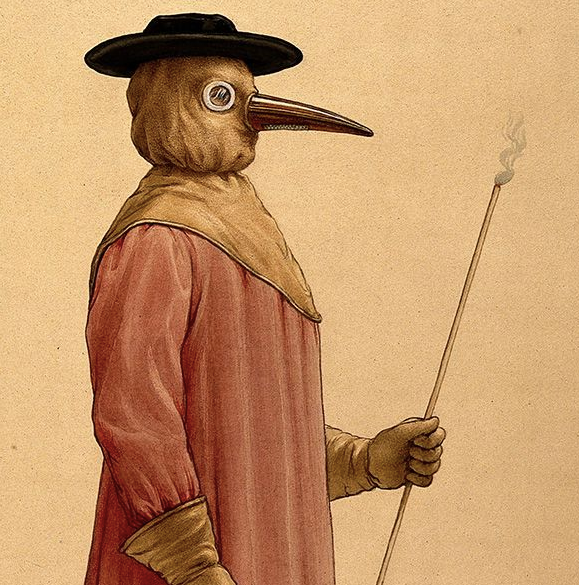
Two faces appear to be wearing clown-like masks. Although this is not a clearly occult image, the material has much in common with the accounts of ritual abuse survivors. In this writer's opinion it is much more strongly indicative of victimization, experience or involvement with actual ritual abuse than Giger's other works that focus on spells or typical occult aesthetic.
Giger also describes his creative process as intuitive, stating that he often does not recognize the artwork until it is complete, and does not feel as if he was the one creating the piece.

If this statement is true, then in this writer's opinion, it is highly suggestive that Giger was abused ritually. Whether he also became a perpetrator later in his life is not clear, but at minimum, he appears to have cognitively been able to choose specific symbols that we now know relate to child abuse.
It is a horrible reality that for some, being a victim of this kind of abuse is intertwined with perpetration: in fact, from the absolute earliest ages, many ritual abuse victims are made to kill small animals and participate in torture, or believe that the torture of others is their fault, in order to indoctrinate such victims into a belief that they are evil and culpable for abuse perpetrated against them and others, whether they are or not. An example from the X-Witness testimony of the Dutroux victims:



This is the despicable reality we face when we see someone like Podesta and his "alter-ego," Skippy. However, that does not absolve adult perpetrators in any way. It is simply something to keep in mind as we view people involved with these circles: victim and perpetrator are not always clearly defined, and this is absolutely intentional.
HR Giger incorporated many occult symbols and themes across his painted works and sculptures, and admitted that at one point in his career he was interested in what he called witchcraft. A quote from Giger on the issue reads as follows:
"At that point in time, I was very much interested in magic and witchcraft. Incidentally, I would like to stress that I have nothing at all to do with Satan and that I detest cruelty to animals. The Spell Temple series, created 25 years ago, contain symbols which certain fools use to try bring me into a relationship with black magic, an association I strongly decline."
Readers can make of that quote what they will: it is my personal opinion that though Giger used overt occult symbols, as he discussed openly on multiple occasions, the heart of his work is not so much to do with occult symbols, but a subconscious portrayal of trauma combined with in-jokes and nods to real practices or code words (as discussed in my previous post on Giger).
Disclaimer: It is extremely difficult to analyze the significance of Giger's occult ties venturing into total speculation. This piece will endeavor to find a narrow balance between becoming overly-speculative and not giving enough weight to Giger's occult connections. Many of the symbols are either difficult to "translate," or lead us into the realm of "conspiracy theory" so deeply that it makes Pizzagate look like material for a college essay.
We know that Giger was heavily influenced by the work of HP Lovecraft, a fantasy-horror author whose work - especially the concept of the Necronomicon - provided inspiration for some Satanists. An essay published on the Church of Satan's website discusses Giger & Lovecraft's Necronomicon(s) and their relevance to Satanic thought.

Above: HP Lovecraft.
Lovecraft's occult leanings are evidenced in the following quote:
“When about seven or eight I was a genuine pagan… I have in literal truth built altars to Pan, Apollo, Diana, and Athena, and have watched for dryads and satyrs…If a Christian tell me he has felt the reality of his Jesus or Jehovah. I can reply that I have seen the hoofed Pan and the sisters of the Hesperian Phaethusa.”
The covers of Giger's 'Necronomicon,' books, a direct reference to HP Lovecraft's fictional grimoire,) are pictured below.

It's not just the Baphomet image on the cover of Giger's first Necronomicon that is a clear occult reference. In Lovecraft's universe, the word Necronomicon was fictionally defined as follows:
"The book was originally called Al Azif, an Arabic word that Lovecraft defined as "that nocturnal sound (made by insects) supposed to be the howling of demons", drawing on a footnote by Samuel Henley in Henley's translation of "Vathek".[11] Henley, commenting upon a passage which he translated as "those nocturnal insects which presage evil", alluded to the diabolic legend of Beelzebub, "Lord of the Flies" and to Psalm 91:5, which in some 16th Century English Bibles (such as Myles Coverdale's 1535 translation) describes "bugges by night" where later translations render "terror by night"."
Although there is much more one could say about Lovecraft's life and work, it is too large in scope to continue in this article. I have instead tried to barely outline the direct overlap between Lovecraft's world-building and Giger's own "inner world."
Another influence on Giger was undoubtedly Aleister Crowley, an English occultist, ceremonial magician, poet, and founder of "Thelema."
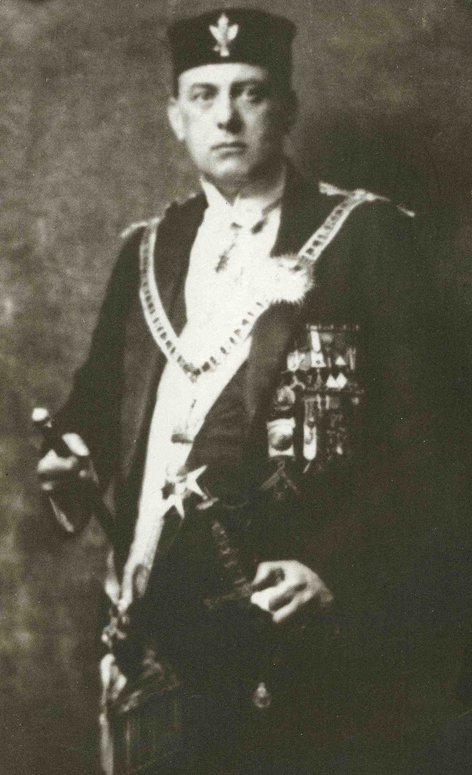
Above: Aleister Crowley in Masonic regalia.
The extent of Crowley's influence on Western Esotericism cannot be summarized in this post, but we note that Giger dedicated the following work to Crowley, naming it after him. The image contains a hermaphrodite with a clown-like face or mask, who is making a "666" symbol in her hands. Another figure to the right of Crowley has their face replaced with the Hindu Yoni-Lingam symbol.
Source: "A Crowley The Beast 666 "
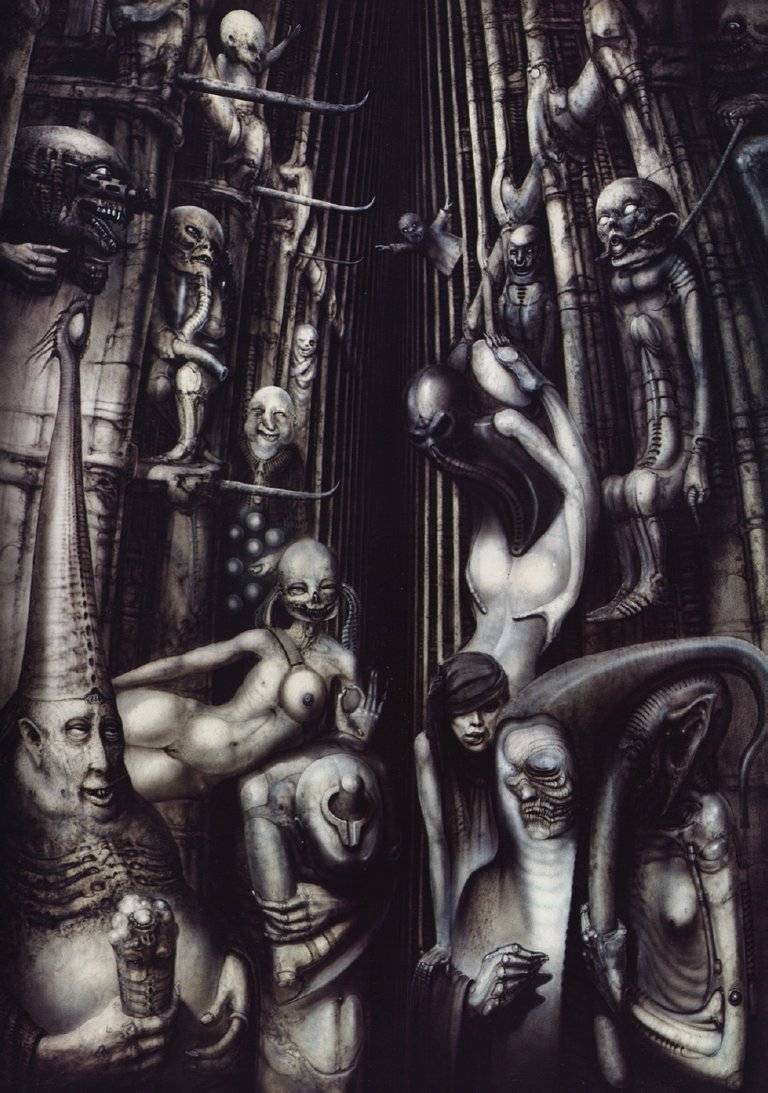
The figure at the bottom left of the work was Giger's representation of Crowley, wearing a conical hat reminiscent of the thorn or break shapes in his 2009 'Caravan' image.
Giger stated that he gave Crowley the hat and "ice cream cone" as a representation of the concept of 'As above so below,' which is also at work in photographs of Giger taken at The Ugly Club,(a venue which will become a focus of discussion later in this series) and is the core meaning displayed in Eliphas Levi's Baphomet image..
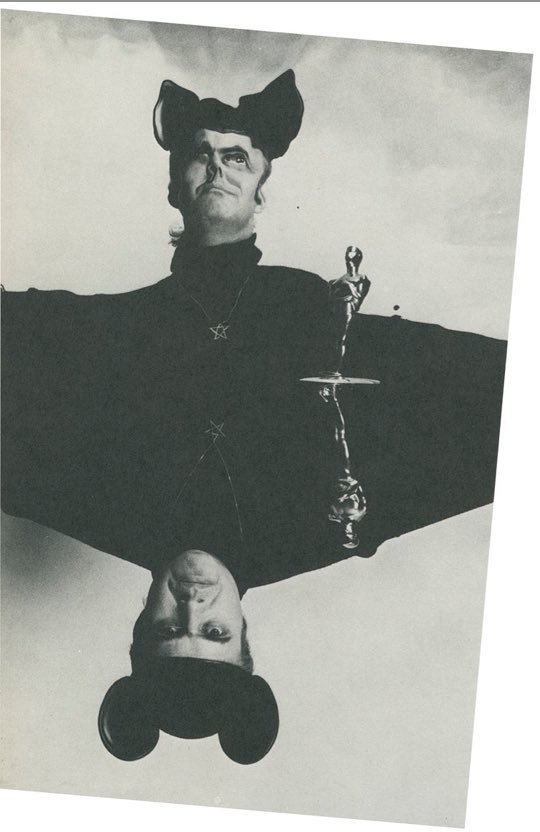
We know that Giger was familiar with this concept, as well as the idea of "reversal," thanks to his own statements regarding his 'Crowley' piece:
"A. Crowley, the best magician, who - with his pointed hat - occupies the left part of the painting. In keeping with the dogma, "below as above", or "Macro-Microcosmos", he holds the reversal of the hat in his hand, an ice-cream cone. "
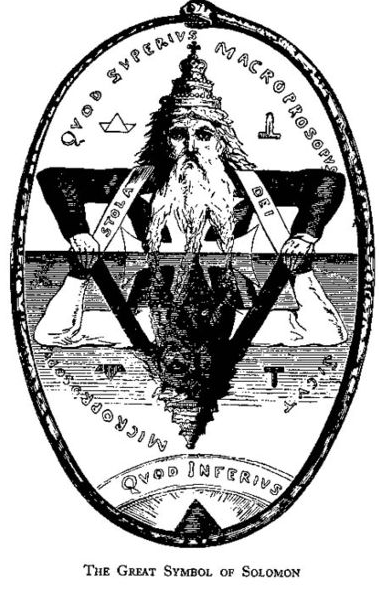
We see the emphasis on distorted reflection in another picture of Giger taken at 'Club Ugly:'
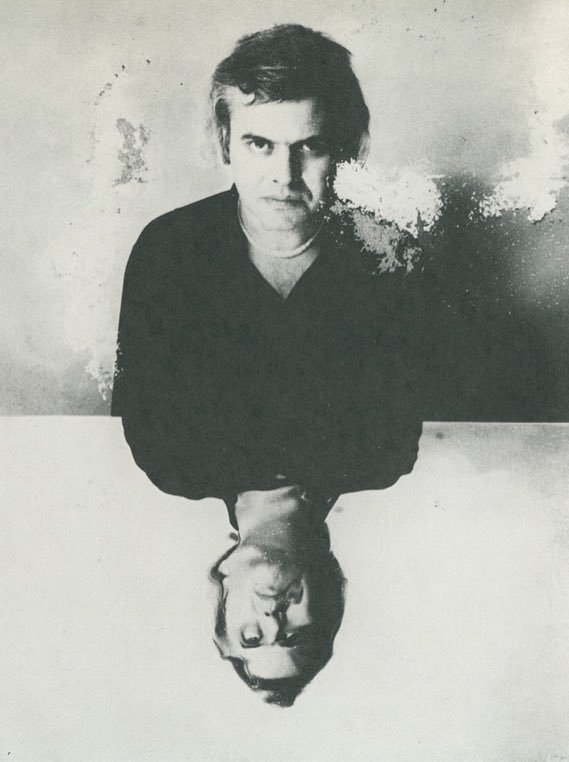
This small section on Crowley does little justice to his influence on Western occult circles, UK military intelligence, etc. However, as in the case of Lovecraft, I have tried to examine Crowley only in the sense of Giger's depiction of him/ inspiration drawn from him.

Eliphas Levi was a radical French socialist, born as 'Alphonse Louis Constant,' whose spiritual ideas were said to have been influenced by his political persuasion. Levi's Wikipedia entry relates:
"[Levi] incorporated the Tarot cards into his magical system, and as a result the Tarot has been an important part of the paraphernalia of Western magicians.[12] He had a deep impact on the magic of the Hermetic Order of the Golden Dawn and later on the ex-Golden Dawn member Aleister Crowley.
[Levi] was also the first to declare that a pentagram or five-pointed star with one point down and two points up represents evil, while a pentagram with one point up and two points down represents good. Lévi's ideas also influenced Helena Blavatsky and the Theosophical Society.[13][need quotation to verify] It was largely through the occultists inspired by him that Lévi is remembered as one of the key founders of the 20th-century revival of magic.[citation needed]"
Below: Giger's Spell IV:
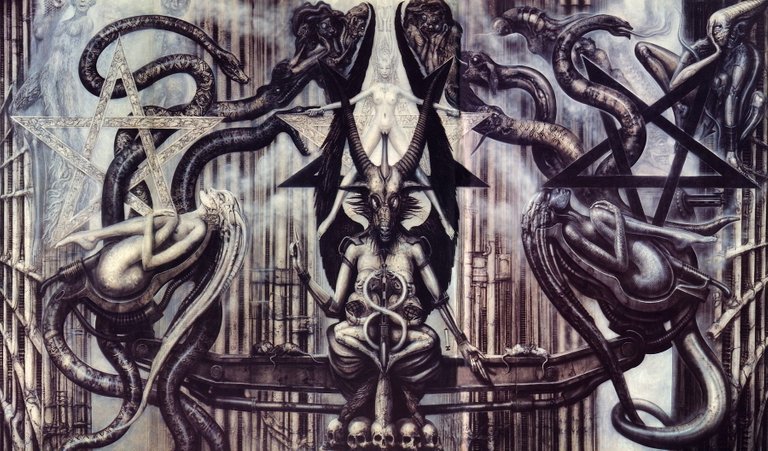
A larger version of Giger's image is available here.
In Giger's Spell IV, he recreates Baphomet amongst multiple pentagrams. The original version drawn by Lévi is included below. The gesture of Éliphas Lévi's Baphomet is known as a representation of 'As Above, So Below.'
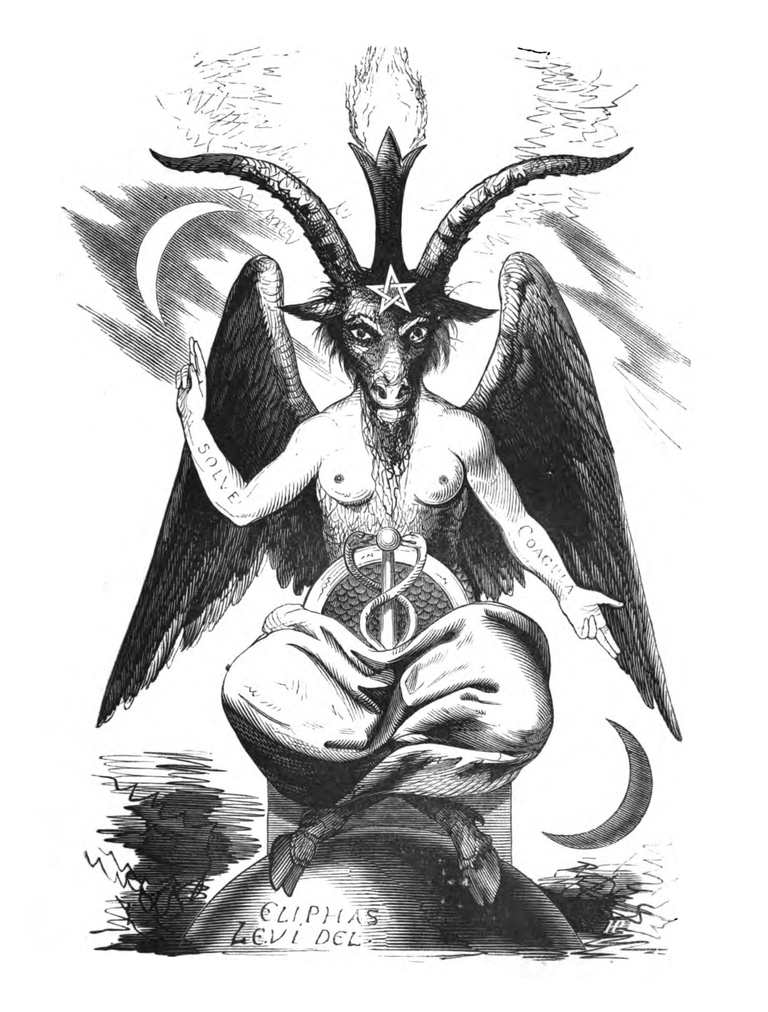
Wikipedia tells us that there is a close connection between Levi's Baphomet and the Tarot, and that Levi believed in an ancient form of pagan witchcraft:
"Lévi's depiction of Baphomet is similar to that of The Devil in early Tarot. Lévi, working with correspondences different from those later used by S. L. MacGregor Mathers, "equated the Devil Tarot key with Mercury," giving "his figure Mercury's caduceus, rising like a phallus from his groin." Lévi believed that the alleged devil worship of the medieval Witches' Sabbath was a perpetuation of ancient pagan rites. A goat with a candle between its horns appears in medieval witchcraft records,[53] and other pieces of lore are cited in Dogme et Rituel."
Given Giger's admission of fascination with Levi, and Levi's association with Tarot, it seems hard to believe Giger's claim that he was essentially unfamiliar with the subject.
Giger's Baphomet figure is positioned in the 'As above, so below' gesture, while impaling a white female figure suspended above his goat-head. Her position, hands outstretched and feet splayed, is also reminiscent of the 'Microcosm & Macrocosm' drawings.
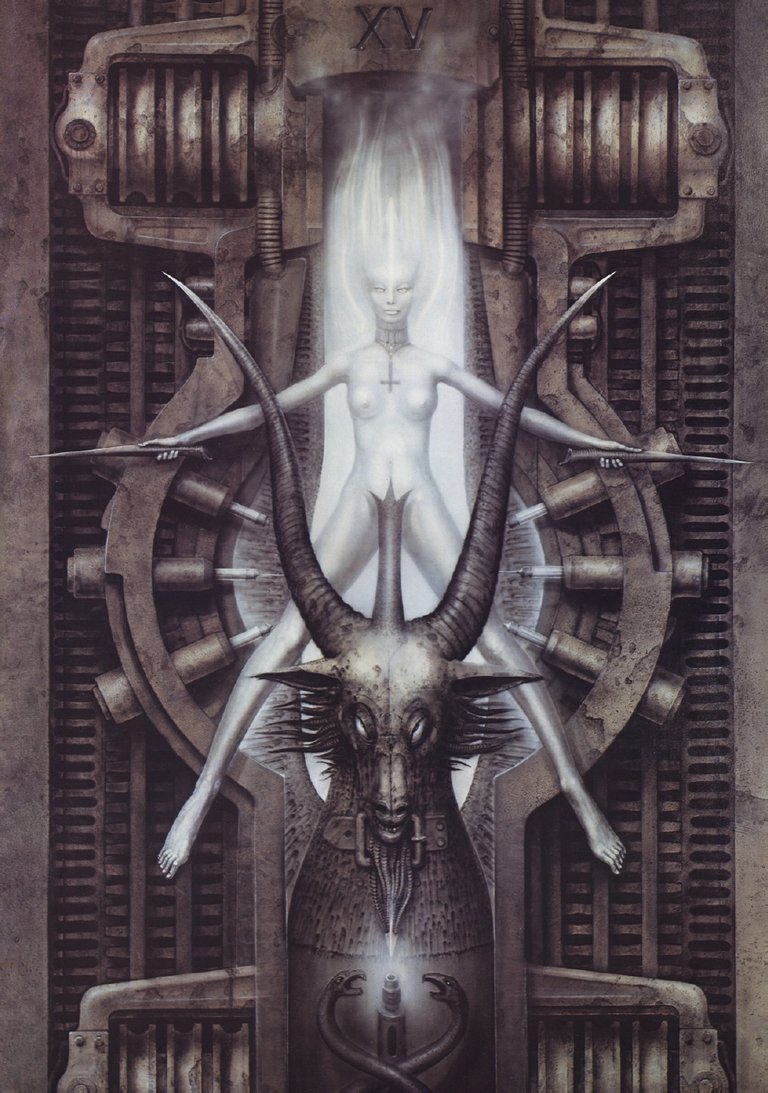
Below, via Wikipedia: Robert Fludd's illustration of man as the microcosm within the universal macrocosm. Fludd states that "Man is a whole world of its own, called microcosm for it displays a miniature pattern of all the parts of the universe. Thus the head is related to the Empyreal, the chest to the ethereal heaven and the belly to the elementary substance."[1]
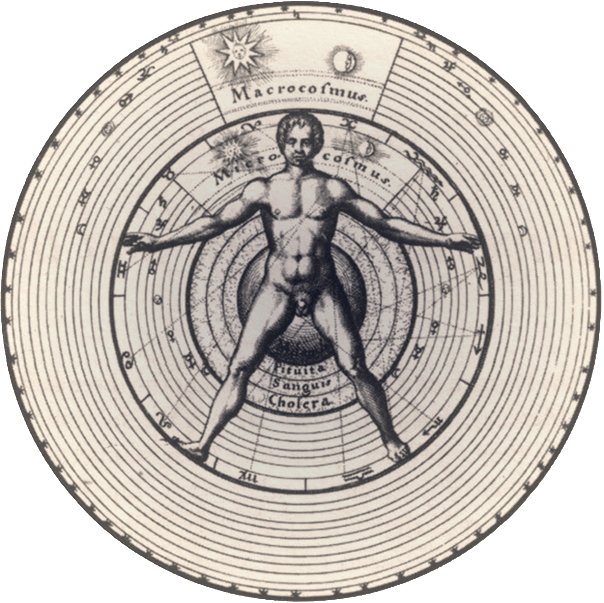
The same concept was at work in Leonardo Da Vinci's famous "Vitruvian Man."
On the right and left side of Spell IV, Giger has an inverted and non-inverted pentagram, as well as a combination of the two pentagrams in the center, behind the white female figure and Baphomet, which also represent the opposition of polar forces, duality, and reversal.
A key phrase in Thoughtco's description of the concept "As Above So Below, in reference to Levi's Baphomet, also relates to balanced duality.

The concept of duality in terms of integrally interlinked opposites was previously discussed by Rob Ager, in Giger's fusion of birth and death. The idea here would be that within birth there is death - whenever any animal is born, their birth ensures their eventual death. Likewise, when that animal dies, their body will be reused and transform into a plethora of other beings, ie, death ensures life.

Such a concept is not ritually abusive or even negative, and is present philosophies like Taoism etc. However, the ritual abuse spin on it, as discussed in my previous piece on Giger, places birth directly within death. This involves some of the worst abuses imaginable to mother and/or child, as documented in both Dutroux victim testimonies, and even pop culture, like the film 'Mother!' It is as much a perversion of duality, as it is a perversion of the Eucharist for Christians.
During the film, Jennifer Lawrence's "Mother" gives birth, pictured below:
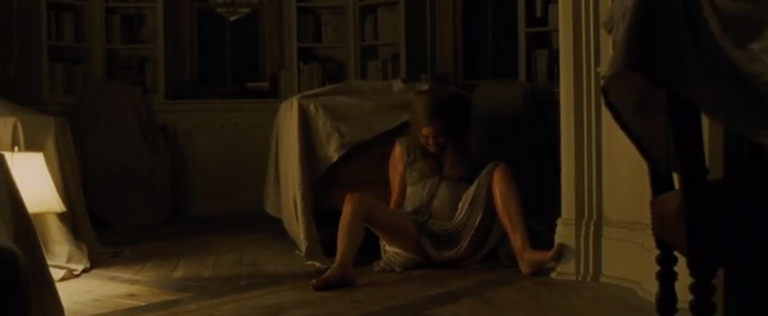
Shortly afterwards (literally the next scene), the newborn boy is killed by a cult, who shares its body as a cannibalistic sacrament:
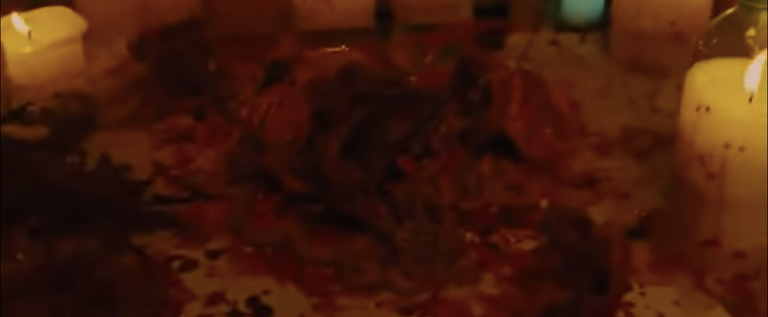
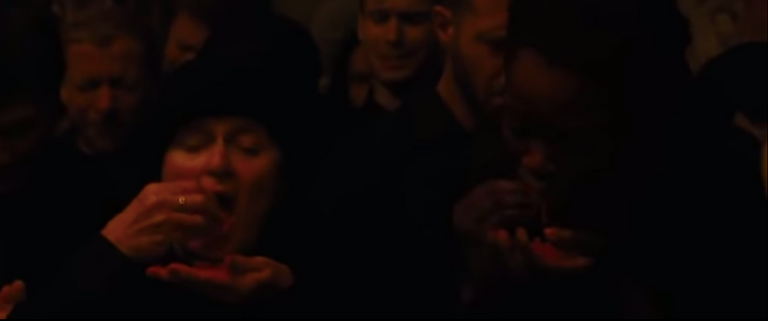
In the Dutroux victim accounts, there are a multitude of abuses of infants, pregnant women and women in labor. This particular account was almost exactly the same as the one depicted in the Mother! film, down to the gender of the child:
"Murder-around... In a circle around fire - have some candles - everybody is standing except the baby and the sheep - the baby cries - he cannot cry - he cannot breathe because he is impure - and it is a boy." She describes the murder of the baby and how his blood is mixed with that of the slaughtered sheep - Then they burn the baby and the sheep, and everybody is having sex with each other - the monster has left. They tear out the heart of the baby. She describes some signs that she noticed (cross - stars"
Wikipedia also describes Levi's intentional depiction of unified duality when creating the Baphomet image reused by Giger:
"Since 1856, the name Baphomet has been associated with a "Sabbatic Goat" image drawn by Eliphas Levi[3] which contains binary elements representing the "sum total of the universe" (e.g. male and female, good and evil, on and off, etc.).[4] On one hand, Lévi's intention was to symbolize his concept of "the equilibrium of the opposites" that was essential to his magnetistic notion of the Astral Light; on the other hand, the Baphomet represents a heretical tradition that should result in a perfect social order, a notion that can only be understood against Lévi's socialist background"
Finally, on close inspection, the woman in one of Giger's depictions of Baphomet appears to be holding a wand that looks remarkably similar to the beaks/thorns in his later 'Caravan' piece.
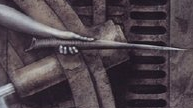
It is also similar to Crowley's above-mentioned conical hat and 'ice cream cone.'
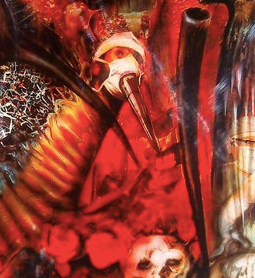
Returning to Levi's Baphomet, it is important to consider the word's history. According to Wikipedia, the name Baphomet first appeared in trial transcripts for the Inquisition of the Knights Templar in the early 14th century.
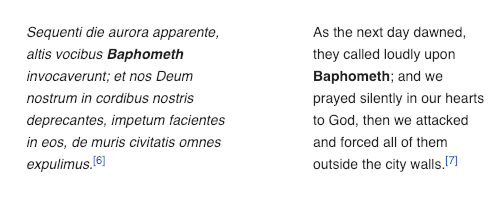
Levi is described expressing the belief that the Templar Order did indeed worship this figure, stating:
"Yes, in our profound conviction, the Grand Masters of the Order of Templars worshipped the Baphomet, and caused it to be worshipped by their initiates; yes, there existed in the past, and there may be still in the present, assemblies which are presided over by this figure, seated on a throne and having a flaming torch between the horns. "
Given that Giger was Swiss, that the Templar Order allegedly created Switzerland, and that Levi believed the Templars worshipped Baphomet, the context for Giger's fascination with the image is compelling in its occult meaning.
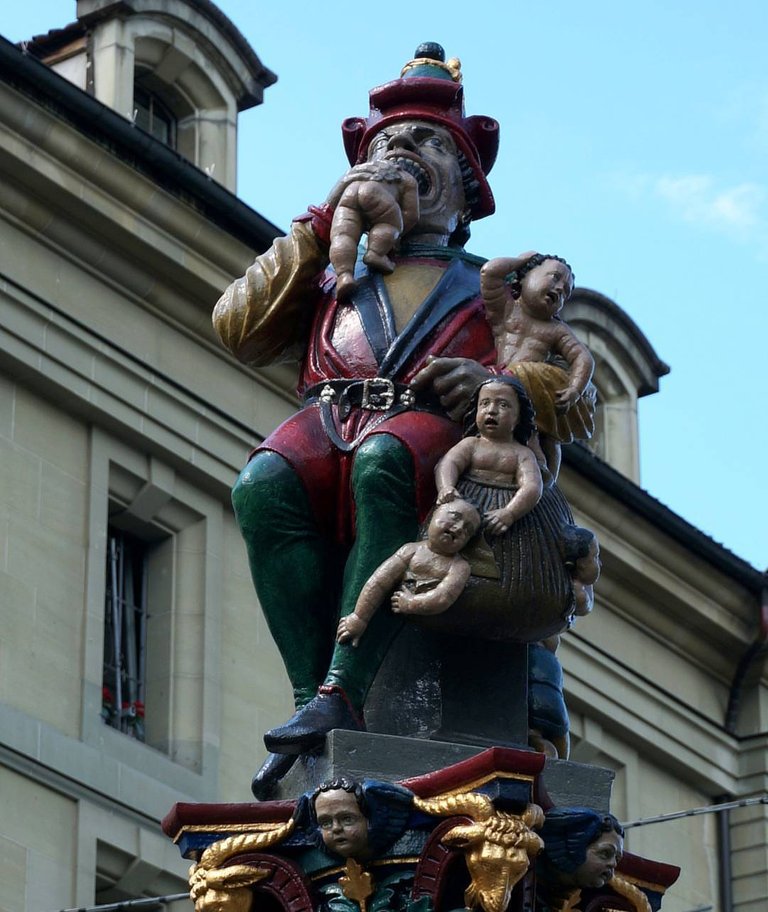
Above: "Child Eater Fountain," in Bern, Switzerland. (Note the goat's heads at the bottom of the image)
Listing an entire nation as a potential occult influence might seem absurd, until we delve into the history of Switzerland and specifically, its association with the Templar Order, which was alleged to have worshipped the same Baphomet that Levi drew, and which later fascinated Giger.
One very long thread describes the history of the Templars, suggesting that the Order essentially founded Switzerland after fleeing France.
Switzerland's Old Confederacy was (conveniently) officially founded in 1291, in close proximity with the dissolution of the Order and in the same exact year as the fall of Acre. Of course, Templars were also something of a precursor to modern banking, an interesting parallel with the history of Switzerland's famous and secret banking.
One author of a book on this topic states in an interview:
"Butler: There are a few important reasons why this is likely to have been the case. For example:
- The founding of the embryonic Switzerland conforms exactly to the period when the Templars were being persecuted in France.
- Switzerland is just to the east of France and would have been particularly easy for fleeing Templar brothers from the whole region of France to get to.
- In the history of the first Swiss Cantons there are tales of white coated knights mysteriously appearing and helping the locals to gain their independence against foreign domination.
- The Templars were big in banking, farming and engineering (of an early type). These same aspects can be seen as inimical to the commencement and gradual evolution of the separate states that would eventually be Switzerland.
- Even the Swiss don’t really know the ins and outs of their earliest history (or suggest that they don’t.) They are famous for being secretive and we don’t have to tell interested readers that this is something they share absolutely with the Templars.
- The famous Templar Cross is incorporated into the flags of many of the Swiss Cantons. As are other emblems, such as keys and lambs, that were particularly important to the Knights Templar."
The famous Swiss Guards are also the oldest military units in the world, and ceremonially protects the Pope in the Vatican to this day.
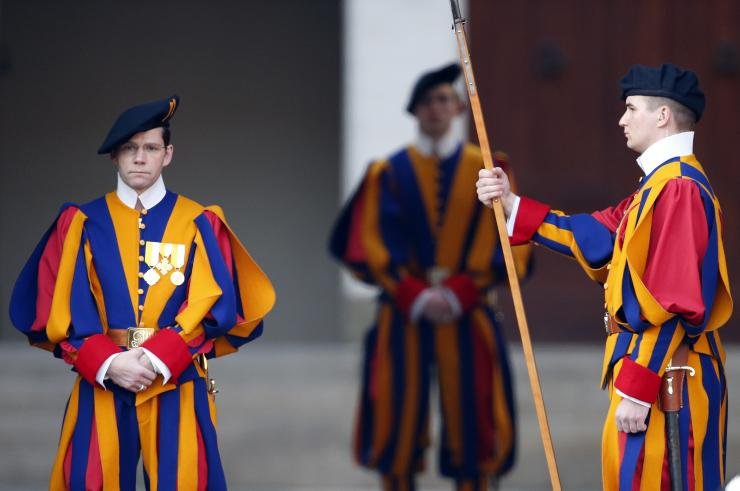
So, can we then trace the influence of the Templar Order in Switzerland, through to Giger's fascination with Levi's Baphomet? I think it is possible, but we cannot know for sure.
Additional intrigue is added to this scenario when considering the (surprising to me) connection between Switzerland and Egypt, which one will find an enormous amount of material, of varying quality, in a cursory search. Prior to researching Giger, I had no idea about the Swiss connection with Templars, possibly Egypt, or any other NWO-type issues, so this line of research is completely new to me. While such a connection may seem extremely unlikely, some news reports stipulate that half of all Swiss men are related to the Egyptian Pharoah, Tutankhamun, via a shared ancestor.
Giger also included Egyptian motifs in his work. For example, in the following work created as a tribute to his close friend and fellow Swiss Artist, Friedrich Kuhn:
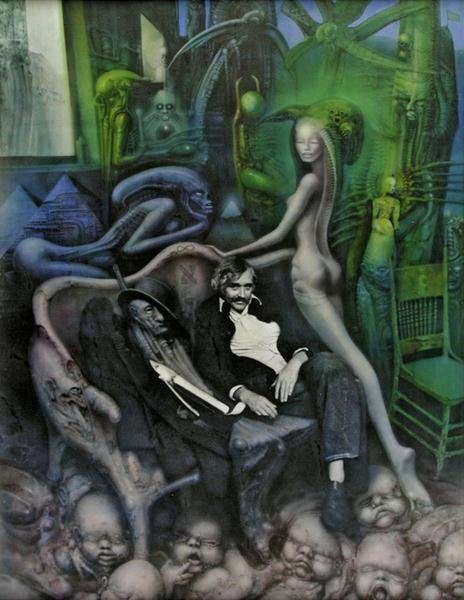
The work includes depicts Egyptian pyramids, and the entire scene rests on a layer of rotting or diseased infants seen in Giger's 'Landscapes.'
Another example of overt Egyptian symbology can be seen in Giger's work titled "Hieroglyphics," pictured below:
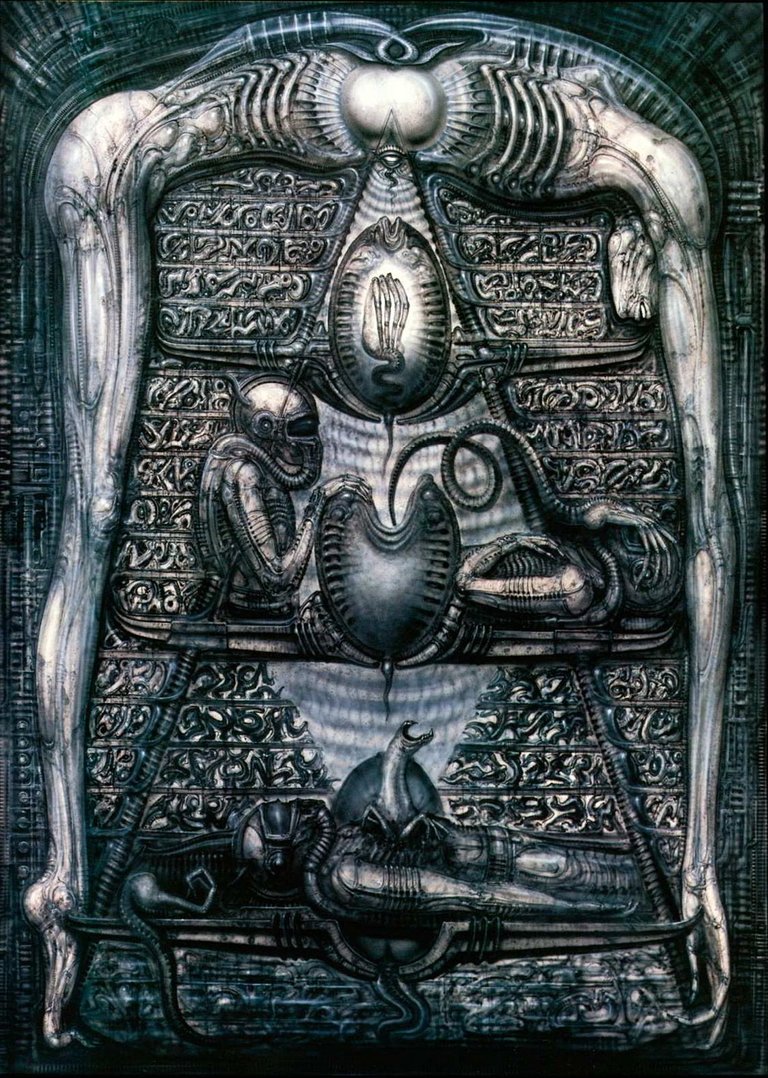
As previously noted by others, this specific piece evokes Egyptian symbolism in more than just name. The arching figure in the painting is based on the Egyptian sky goddess, Nut/Nuit.
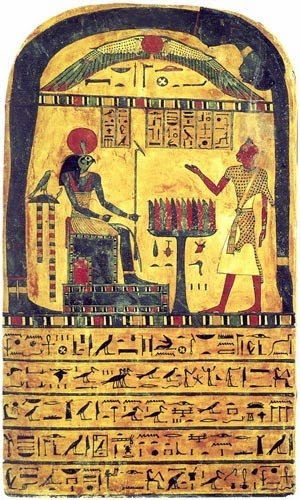
One does not have to stretch the imagination far in order to also recognize the Masonic symbol of the triangle topped by a radiating all-seeing-"eye" in Giger's version of this image.
In addition to the above-mentioned piece, Giger's work in general has the appearance of flat, almost two-dimensional, forward-facing displays, as if the viewer is looking at a carving on a wall, much as Egyptian art is painted and carved into the sides of temples and tombs. For example:
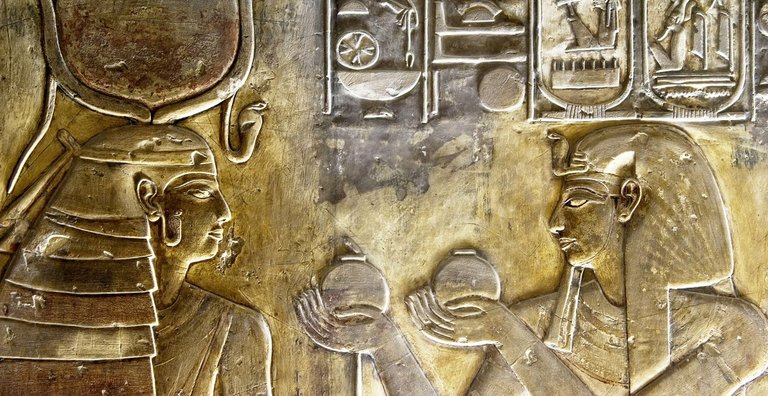

Another occult influence for Giger appears to have been Timothy Leary, whose face Giger included in Illuminatus I, seen below. The image continues Giger's use of Egyptian symbolism, including a pyramid, the Eye of Horus, an Ankh at the bottom of the image, etc.

The apple on top of the pyramid is interesting, in that the Adamic apple was the fruit of the tree of knowledge, hence, ultimate - if illicit or forbidden knowledge - and therefore "Illumination"is placed at the top of the pyramid. The placement of the safety pin piercing the female's mouth seems to connote the "safety" of a violently enforced code of silence at the base of the pyramid.
Another piece, Illuminatus II, includes phrases written on the razor blades: "OTO," "Illuminatus," "666," "Cocaine (?)," and "Acid."
Now you may be objecting to the appraisal of Leary as an occult influence, given that most are aware that Timothy Leary and his cohorts were part of the impetus behind the psychedelic movement in the '60s and his purported association with the CIA. However, Leary also claimed on PBS that he was "carrying on the work" of Aleister Crowley:
According to Wikipedia, Leary was also a member of "Illuminates of Thanateros," which is described as:
"An international magical organization that focuses on practical group work in chaos magic. The idea was first announced in 1978, while the order proper was formed in 1987. This fraternal magical society has been an important influence on some forms of modern occultism."
By including what appear to be likenesses of Leary, Lovecraft and others in a painting titled "Illuminatus," Giger expresses an awareness of Leary's occult connections in addition to his work in the psychedelic realm. This communicates that at minimum Giger was running in similar circles.
Finlay, a 'pulp fiction illustrator,' appears in Giger's Illuminatus I along with Lovecraft and Leary. This makes sense for multiple reasons, one being Finlay's correspondences with HP Lovecraft, whose work Finlay sometimes illustrated. Lovecraft praised Finlay's work:
"I liked the [Virgil Finlay] illustrations to my two tales—indeed, I believe Finlay is the best all-around artist Weird Tales has ever had. His drawing for the Doorstep was really an imaginative masterpiece. Wright has generously presented me with the originals of both Haunter and Doorstep pictures—and they far transcend the mechanical reproductions."
—HPL in a letter to James F. Morton on the spectacular art of Virgil Finlay. Dated to March of 1937.
Finlay's work often includes occult and macabre themes.
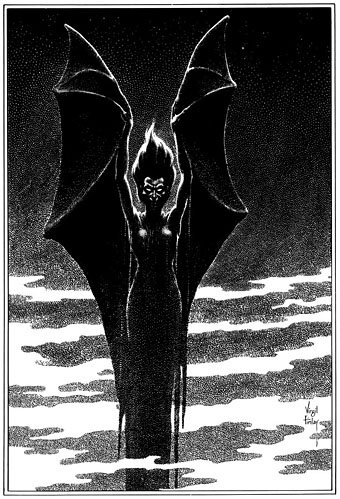
Whether Finlay was actively involved with the occult in some way beyond his artistic expression is not clear, and no information on his membership in Masonic, occult or other similar groups was available after researching the subject.
.jpeg)
Above: Sergius Golowin, by HR Giger.
The final likeness included in Giger's 'Illuminatus I' was his friend, the Swiss Folklorist Sergius Golowin, whose Wikipedia entry states:
"Sergius Golowin wrote numerous books and articles, primarily about folklore and esotericism. For his work in folklore and exploring the counterculture, he was awarded the prize of the Schweizerische Schillerstiftung in 1974."
"Golowin was a contemporary of many notable people and events. He provided assistance to Timothy Leary while Leary was in Swiss exile. Golowin was a friend of Friedrich Dürrenmatt, and was portrayed by H. R. Giger... Golowin was an acquaintance of Martin "Tino" Schippert, founder of the Swiss Hells Angels."
In this light, Giger's portrayal of Golowin with Leary makes complete sense, and the former's interest in esotericism makes his inclusion in a work titled 'Illuminatus' self-explanatory.
Clearly, Giger's work very carefully incorporates and draws from real and fictional (Lovecraftian) occult material. The inclusion of this subject matter is not in question: the question comes when we try to determine meaning from Giger's occult references and ties. In order to do so, we need to look at not only Giger's symbols, but also important events from Giger's life. For that reason, in the next segment in this series we turn to the death of Giger's first muse and long-time partner, Li Tobler.
Curated for #informationwar (by @openparadigm)
Ways you can help the @informationwar!
FreezePeach
I have no idea what FreezePeach is lol, but ok.
"Free Speech" :)
Good to know! Thank you :)
Congratulations @whitedeer9217! You have completed the following achievement on the Steem blockchain and have been rewarded with new badge(s) :
Click here to view your Board
If you no longer want to receive notifications, reply to this comment with the word
STOPDo not miss the last post from @steemitboard:
Congratulations @whitedeer9217! You received a personal award!
You can view your badges on your Steem Board and compare to others on the Steem Ranking
Do not miss the last post from @steemitboard:
Vote for @Steemitboard as a witness to get one more award and increased upvotes!